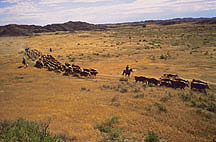|

Click image for caption and other photo information.
|
Montana Research Facilities To Expand
By Amy Spillman
August 9, 2002
One of the largest research facilities in the world is breaking ground today to expand its main laboratory complex. The Fort Keogh Livestock and Range Research Laboratory, operated by the U.S. Department of Agriculture's Agricultural Research Service, covers 55,000 acres of native rangeland, planted dryland, irrigated pasture and irrigated cropland near Miles City, Mont. A USDA facility since 1924, Fort Keogh has more than 40 permanent employees, as well as 25 working horses and a herd of about 1,500 cows.
ARS, the USDA's primary scientific research agency, operates the facility in cooperation with Montana State University's Agricultural Experiment Station. Fort Keogh researchers focus on beef cattle genetics and reproductive physiology, range animal nutrition and range ecology and management. Over the years, they have pioneered methods for genetic evaluation of beef cattle and established a purebred Hereford line that is a cornerstone of the breed. They have also helped ranchers in the Northern Plains reduce soil loss, enhance plant growth and increase production of domestic livestock and wild animals.
Fort Keogh's main lab is nearly 30 years old. In 2000, Congress awarded $5.3 million to USDA to replace its outdated and worn building components and accommodate an expanding research and customer education program at the facility.
Tomorrow, ARS will dedicate another world-class research facility in Montana, the Northern Plains Agricultural Research Laboratory (NPARL) in Sidney. Scientists at NPARL address problems of rangeland, dryland and irrigated agriculture in the cool, semiarid region of eastern Montana and western North Dakota. The MonDak region is traversed by the Yellowstone and Missouri rivers and remains one of the last large areas in the country with the potential for expanded irrigation development.
Currently, NPARL researchers focus on the biological control of noxious weeds, insect pests and fungal pathogens; the ecology and management of grasshoppers; and the development of sustainable irrigated and dryland agricultural production systems. They also coordinate the successful areawide program to control leafy spurge, a noxious weed infesting 5 million acres in 36 U.S. States and Canadian provinces. Past research efforts have focused on wind erosion control, saline seep reclamation and conservation tillage techniques.
Established in 1965, NPARL began adding its new lab/office complex in May 2000. Plans for a biocontainment facility and greenhouses have also been approved, but their construction has not yet been funded.
|

